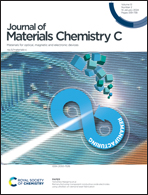Host–guest complexes of perylene bisimide-based metallacage and fullerenes for efficient photoinduced charge separation†
Abstract
The discovery of coordination-driven self-assembly has greatly expanded the field of organic macrocyclic compounds. This approach enables the construction of precise supramolecular complexes, known as metallacages, assembled from organic ligands coordinated with metal centers. Metallacages come in various sizes and shapes, making them capable of hosting guest molecules of different sizes. In this work, we report the ground and excited state properties of non-covalent complexes between various fullerenes (C60, C70, Sc3N@C80, Sc3CH@C80, and Sc4O3@C80) and Pt6PBI3 metallacage, composed of perylene bisimide units and organoplatinum nodes. These complexes exhibit thermodynamically favorable photoinduced charge transfer from endohedral metallofullerenes to metallacage that occurs within picoseconds. Among the systems considered, the Pt6PBI3⊃Sc3N@C80 complex stands out as the most promising candidate for use in photovoltaics due to its ability for fast charge separation and slow charge recombination.



 Please wait while we load your content...
Please wait while we load your content...